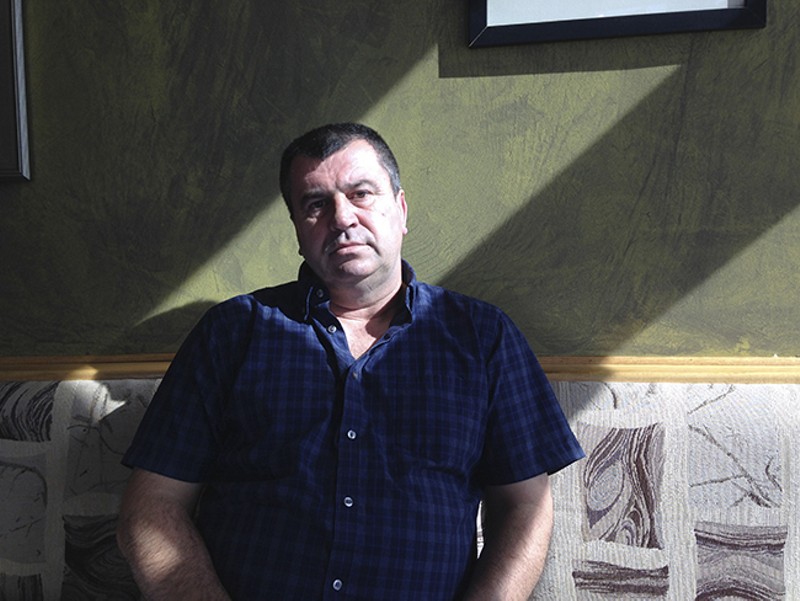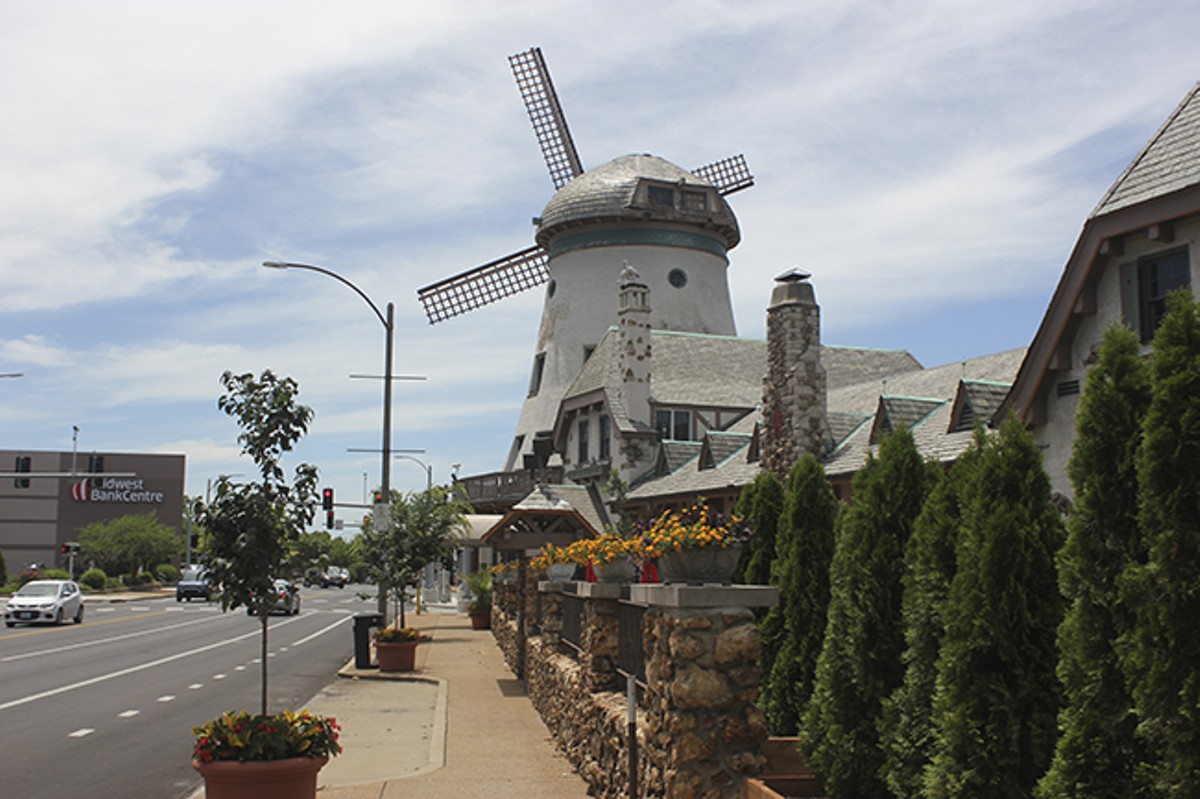
Vajzovic and his family lived in an apartment complex off of Gravois at the southern tip of Bevo. Fourteen Bosnian families stayed in the twenty-unit building back then.
"We were like one big family, like Little Bosnia in that building," he says.
Now, people look back at the refugees' history in St. Louis as a huge boost for Bevo and the city, but Crosslin remembers all the complaints that flooded the institute during the early years. Neighbors bitched about the shoes left on front porches and the smoke from the backyard smokehouses built by some Bosnians. Little old ladies would see a group of refugees roasting a goat and swear they had the family pet on the spit.
"Oh my God, we had calls here constantly," Crosslin says. "We had people call that they were barbecuing dogs, 'they're killing sheep, there's rivers of blood.'"
The Bosnians were, of course, not cooking dogs, but the fear of newcomers was not anything new, either. Crosslin remembers a similar surge of complaints when the Vietnamese began moving into south city a few decades before that. Everyone has finally settled down, and the Bosnians impressed their new city with their industriousness and aptitude for business.
Bevo also saw a resurgence.
"It was all boarded-up," Crosslin says. "It got a second breath from the Bosnian resettlement."
Vajzovic, who had earned a master's in engineering in Bosnia, started over in St. Louis. His first job was an entry-level position at a print shop that paid $8 an hour, and from there he began to build.
Now an instructor of business management at Webster University after earning a master's and then a doctorate there, Vajzovic and his wife own several businesses. First Bosnian on Gravois is their insurance agency. They recently sold off a successful trucking operation, and their real estate business has about forty properties, including that twenty-unit apartment building where they first lived.
Their family, too, has flourished. His daughters graduated from two of the country's top law schools, University of Chicago and Harvard, and work in Chicago and New York. His son has a master's in engineering from Washington University.
Vajzovic and his family are among countless success stories of Bosnian refugees in St. Louis. For this, he is grateful, and particularly grateful to Bevo.
"The neighborhood is very friendly to us," he says.
Vajzovic was part of a group that has worked in recent years to establish a new development district in Bevo. It was easy enough to see that Bosnian businesses alone would not be able to sustain the neighborhood into the future. They needed an infusion of diverse newcomers. So he and others began collecting signatures for what would eventually become the Bevo Community Improvement District. Approved last year, the district covers a strip of Gravois from Taft Avenue in the north to Christy Avenue in the south. The new board has hired Park Central Development, the neighborhood planners whose résumé includes similar districts in the Grove and Central West End.
They don't have a lot of money — voters rejected a one percent sales tax, leaving only a special assessment on property owners in the district — but they plan to start by reinvigorating Bevo's image. Hannah Curtin of Park Central says they're working on a new logo and plan to start small with a "This Could Be" campaign of covering the windows of empty storefronts with posters detailing potential uses for the spaces.
The board hopes a second run at the sales tax vote will eventually help fund additional security and infrastructure projects, which could include pedestrian lighting. Board Chairman Sadik Kukic says they have set a goal of attracting one new business a month to Bevo.
"We have to bring life to the neighborhood," he says.
Kukic, who came to St. Louis in 1993 from a concentration camp, says he sees similarities to South Grand, where an abundance of Vietnamese restaurants started by that earlier wave of refugees have melted into an international mix of restaurants, bars and shops.
"People are still thinking about old things happening here," says Kukic, who is also president of the Bosnian Chamber of Commerce. "I think a lot of things are changing."

Everyone in Bevo Mill talks at some point about crime. Opinions are split about whether it gets too much attention or not enough, but the topic is unavoidable.
"Last year there was a shooting," Mina Omerovic says one afternoon in her kitchen.
The 33-year-old housekeeper is one of the few Bosnians who have stayed in the neighborhood. She's talking about a 73-year-old man who police say gunned down a pair of armed robbers in February 2016 when they ambushed him in his garage. The bloody showdown happened in the middle of the afternoon about four blocks south of where Omerovic lives with her husband and five kids. Now, she keeps the door to her backyard shut, even when it's warm and she would prefer the breeze.
At times, some Bosnians have felt like crimes against their community have gone unnoticed. When 32-year-old Zemir Begic was bludgeoned to death with hammers in the early morning hours of November 30, 2014 on Itaska Street, dozens of Bosnians protested in the middle of Bevo. Some held signs that said "Bosnian Lives Matter." Police arrested four teens in the attack, one of whom has pleaded guilty to second-degree murder.
"Morganford used to be like a small community in Bosnia," Omerovic says. "Everybody like Morganford, like Bevo Mill. Now it's 2017. People move."
She does not blame those who go — everyone has to do what they think is best for their families — but she still has a few friends and family members nearby. Ultimately, she figures crime can happen anywhere, even the county, so she and her family are staying for now.
There are certainly more dangerous places. When then-Mayor Francis Slay and Alderman Antonio French identified Bevo in December 2015 as one of fifteen high-crime neighborhoods to be targeted for services as part of a new plan to reduce crime in the city, they put it on a list with places such as south city neighbor Dutchtown and Wells Goodfellow in north city, where crime totals are far, far worse. Bevo was actually the safest of all the neighborhoods on the list, but it's not exactly a selling point to say you're only the fifteenth most dangerous of the city's 79 neighborhoods.
"The biggest challenge is to make people aware that we have businesses here that are thriving and that it's safe," Howard, the alderwoman, says.
She admits security has been a concern but insists perception is much worse than reality. Less than a week after Begic was killed, a woman claimed four young black men forced her out of her car, robbed her at gunpoint and said they should kill her because she was Bosnian. The story made headlines as a possible hate crime, but it was later revealed to be a hoax when police found video that showed the woman was never approached by anyone, much less attacked.
Bevo's reputation for crime often overshadows better characteristics of the neighborhood, Howard says, such as a comparatively affordable cache of houses. The alderwoman suspects that may be changing. Building permits are up, she says, and she sees anecdotal evidence in the 35- and 40-year-olds she has noticed moving in. They, like the Bosnians before them, seem to be finding a neighborhood with potential.
Perhaps the most encouraging sign for neighborhood watchers was the opening of Das Bevo. Owners Carol and Pat Schuchard say they considered crime before buying the mill from the city in May 2016.
"We at first wanted to make sure it was safe," says Carol, an artist who also owns event spaces Majorette and the Boo Cat Club with her husband.
What they saw didn't scare them. They have spent the thirteen months since their purchase working day and night to restore the landmark, which includes a massive beer hall, wide patio, underground event space and even bedrooms up in the windmill tower that they eventually plan to rent out for overnight stays. Now, with Das Bevo up and running, the Schuchards say their early assessments of the neighborhood as a safe place and good investment have proven correct.
"You would think there are assassins lining up on Gravois," Carol Schuchard says of Bevo's reputation. "It's not that way at all."






